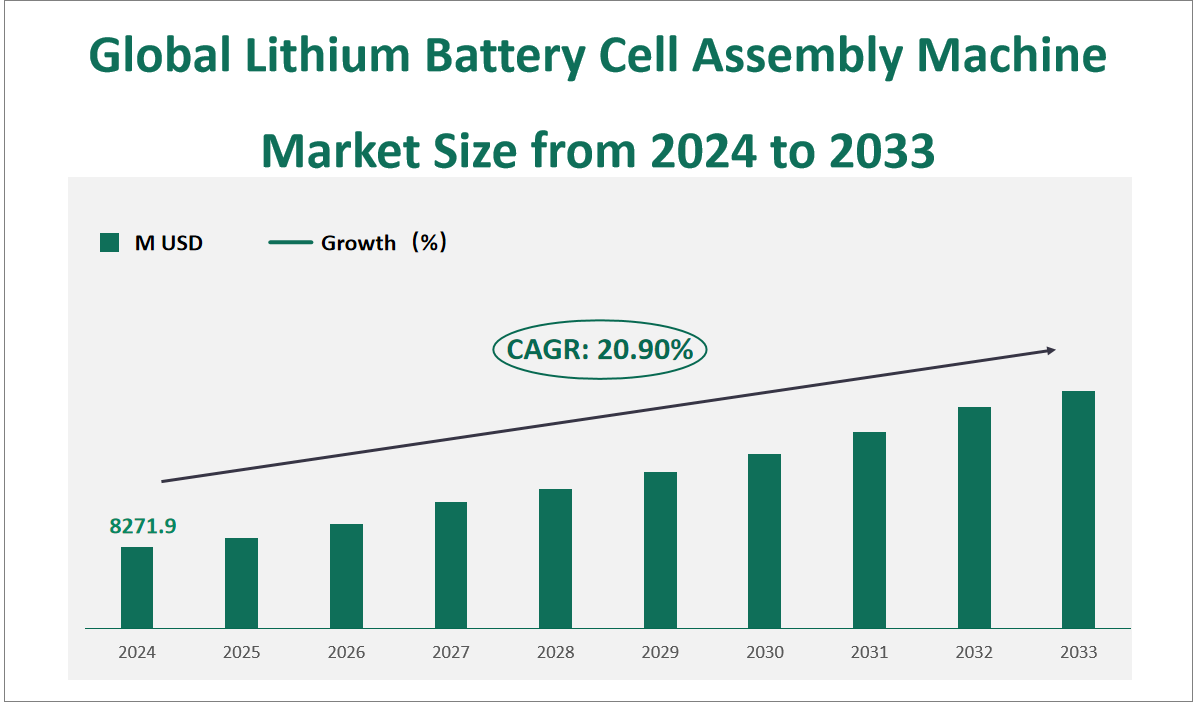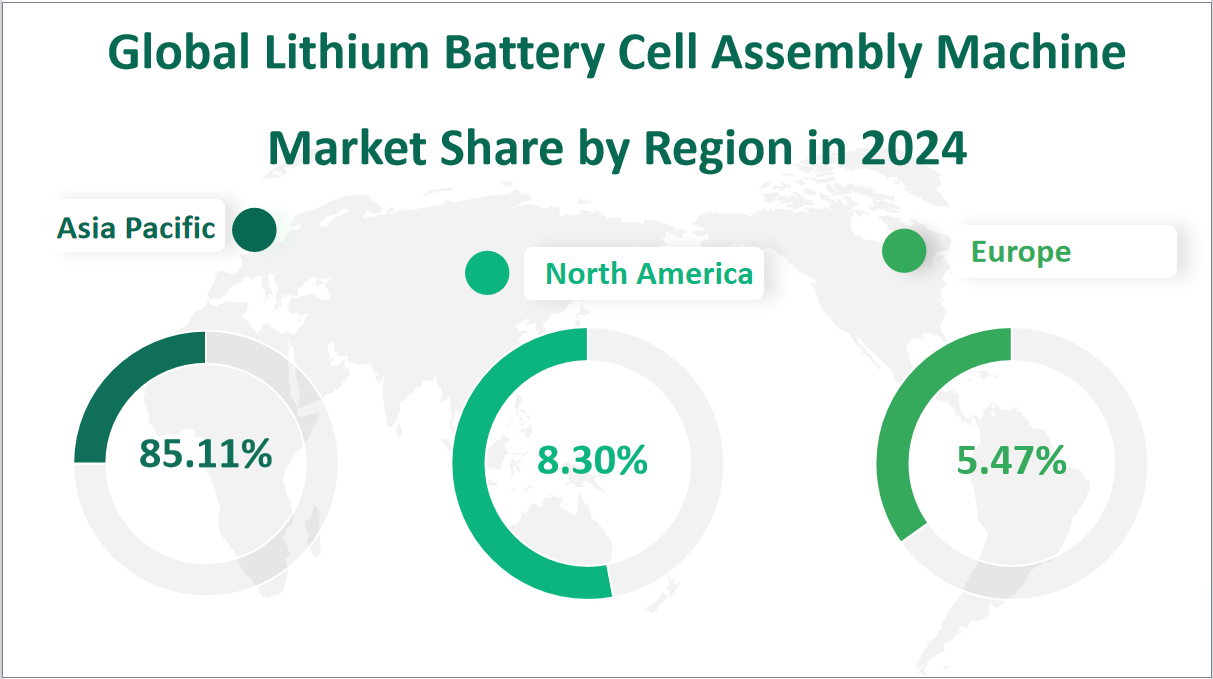1 Global Lithium Battery Cell Assembly Machine Market Outlook
The global Lithium Battery Cell Assembly Machine market is projected to exhibit substantial growth in the coming years, with a CAGR of 20.90% from 2024 to 2033, reaching a total market size of $8271.9 million USD in 2024. Lithium Battery Cell Assembly Machine is an automated assembly system specially designed for secondary battery assembly. In the lithium-ion battery assembly process, the positive electrode (anode) is first stacked on the negative electrode (cathode), and then pressed several times until the electrode materials are in firm contact with each other. The main function of the Lithium Battery Cell Assembly Machine is to fill the electrolyte or mercury dispensing device to a specific level for commercial batteries. Processes part parts and dumps them into the relevant feeders on the conveyor belt.
Figure Global Lithium Battery Cell Assembly Machine Market Size and Growth Rate (2024-2033)

2 Lithium Battery Cell Assembly Machine Market Growth Drivers and Constraints
The growth of the Lithium Battery Cell Assembly Machine market is driven by several key factors. The rapid development of the new energy vehicle industry has increased the demand for lithium batteries, making these assembly machines crucial for automotive lithium battery production. Additionally, the global economy’s growth and population increase have led to a surge in market demand, actively promoting the expansion of the Lithium Battery Cell Assembly Machine market. Technological innovations in battery manufacturing and the push for more sustainable energy solutions also contribute to the market’s growth.
However, the market faces certain limitations. High production costs and complex processes are significant constraints, affecting the quality and large-scale industrialization of Lithium Battery Cell Assembly Machines. Technical challenges, such as low yield and difficulty in film transfer, directly impact the production efficiency and profitability of enterprises. Furthermore, the market is affected by fluctuations in raw material prices, which can increase the cost of raw materials for Lithium Battery Cell Assembly Machine Manufacturing, thereby affecting the production and operation of enterprises and corporate profits.
3 Lithium Battery Cell Assembly Machine Market Innovations and M&A Activities
The Lithium Battery Cell Assembly Machine market is characterized by continuous technological innovation and strategic corporate activities.Technological innovation is a key driver, with companies focusing on optimizing process parameters to synthesize graphene with large area, high quality, and controllable layer numbers. This innovation aims to enable direct growth on ideal substrate materials, potentially eliminating the transfer step and reducing production costs.
In terms of corporate activities, mergers and acquisitions have been a key strategy for market players to expand their reach and strengthen their market positions. For instance, Grahope New Materials acquired 70% of Wuxi Graphene Film, a significant move in the industry. Expansions and collaborations are also prevalent, with companies like General Graphene launching new high-capacity CVD graphene roll-to-roll production lines, enhancing their manufacturing capabilities and meeting the growing demand for consistent, industrial-volume graphene.
The industry is also marked by new product developments, such as large-sized CVD graphene on copper foil or PET, which are set to revolutionize applications in flexible and rigid touch screen displays, energy electrodes, lightweight composite materials, and more. These innovations signal a progressive shift towards more diverse and sophisticated applications of Lithium Battery Cell Assembly Machine, further solidifying its position in the global market.
4 Global Lithium Battery Cell Assembly Machine Market Analysis by Type
In 2024, the global Lithium Battery Cell Assembly Machine market is forecasted to exhibit a significant market size for various types of assembly machines. The Winding/Stacking Machine is anticipated to hold the largest share with a market size of $5,042.4 million USD, capturing a substantial portion of the total market. The Welding Machine is projected to have a market size of $1,324.6 million USD, while the Filling Machine is estimated to reach $715.6 million USD. Additionally, the Others category is foreseen to amount to $1,189.4 million USD. These figures together contribute to the overall market size, which is predicted to be $8,271.9 million USD for the year 2024. The market size share for each type in 2024 is as follows: Winding/Stacking Machine with 60.96%, Welding Machine with 16.01%, Filling Machine with 8.65%, and Others with 14.38%, illustrating the dominance of the Winding/Stacking Machine type in the Lithium Battery Cell Assembly Machine market.
Table Global Lithium Battery Cell Assembly Machine Market Size and Share by Type in 2024
Type | Market Size in 2024 (M USD) | Market Share in 2024 (%) |
|---|---|---|
Winding/Stacking Machine | 5042.4 | 60.96% |
Welding Machine | 1324.6 | 16.01% |
Filling Machine | 715.6 | 8.65% |
Others | 1189.4 | 14.38% |
5 Global Lithium Battery Cell Assembly Machine Market Analysis by Application
In 2024, the global Lithium Battery Cell Assembly Machine market is projected to demonstrate a notable distribution across various applications, with the market size for Consumer Electronics reaching $2,412.1 million USD and holding a market share of 29.16%. The Power application is anticipated to command a more significant share with a market size of $4,835.4 million USD, accounting for 58.46% of the total market. The Others category is forecasted to have a market size of $1,024.4 million USD, representing 12.38% of the market. Collectively, these applications are expected to contribute to an overall market size of $8,271.9 million USD in 2024, with the market size shares reflecting the diverse applications and their respective importance in the Lithium Battery Cell Assembly Machine industry.
Table Global Lithium Battery Cell Assembly Machine Market Size and Share by Application in 2024
Application | Market Size in 2024 (M USD) | Market Share in 2024 (%) |
|---|---|---|
Consumer Electronics | 2412.1 | 29.16% |
Power | 4835.4 | 58.46% |
Others | 1024.4 | 12.38% |
6 Global Lithium Battery Cell Assembly Machine Market Analysis by Region
In 2024, the global Lithium Battery Cell Assembly Machine market is forecasted to exhibit a substantial market size across different regions. The North American region is projected to have a market size of $686.2 million USD, capturing a market share of 8.30%. Europe is expected to contribute a market size of $452.2 million USD, with a 5.47% share. The Asia Pacific region, being the most significant, is anticipated to reach a market size of $7,040.1 million USD, accounting for an 85.11% share. The Others category is foreseen to amount to $93.5 million USD, representing a 1.13% share. Together, these regions contribute to the total global market size, which is projected to be $8,271.9 million USD for the year 2024.
Figure Global Lithium Battery Cell Assembly Machine Market Share by Region in 2024

7 Top 3 Companies of Global Lithium Battery Cell Assembly Machine Market
7.1 Wuxi Lead
Company Introduction and Business Overview:
Established in 2002, Wuxi Lead is a leading manufacturer of new energy equipment with a global presence. The company has carved a niche for itself in seven major industries, including lithium-ion batteries, photovoltaics, 3C, warehousing and logistics systems, automobiles, fuel cells, and lasers. As a world leader in lithium-ion battery equipment, Wuxi Lead has established strategic partnerships with renowned battery companies such as Panasonic, Sony, Samsung SDI, LG Chem, Ningde Times, and BYD.
Products Offered:
Wuxi Lead specializes in lithium battery intelligent manufacturing, providing complete line solutions with 100% independent intellectual property rights. Their core equipment boasts a market share exceeding 60%. The company is committed to offering comprehensive services from battery manufacturing, assembly, testing, to module PACK and intelligent logistics systems, equipped with the MES intelligent manufacturing system developed in-house.
Sales Revenue in the Latest Year:
Wuxi Lead achieved a remarkable revenue of $704.3 million USD, with a gross margin of 30.92%. This revenue figure underscores Wuxi Lead’s significant contribution to the global lithium battery cell assembly machine market and its financial strength.
7.2 Yinghe Technology
Company Introduction and Business Overview:
Shenzhen Yinghe Technology Co., Ltd., established in 2006, is dedicated to the research, development, production, and sales of intelligent new energy automation equipment. The company has emerged as a leader in the field of power battery intelligent automation equipment and is one of the few companies globally that can provide power battery intelligent digital factory solutions.
Products Offered:
Yinghe Technology’s product lineup includes a single-layer extrusion coating machine capable of handling up to 1600mm in drum width and offering coating speeds of up to 110 meters per minute. The machine is designed for high precision and efficiency, with features like unwinding diameter up to 800mm and rewinding roll diameter up to 1200mm.
Sales Revenue in the Latest Year:
Yinghe Technology reported a revenue of $444.2 million USD, with a gross margin of 17.04%. This indicates the company’s strong market position and its ability to maintain profitability amidst competitive market conditions.
7.3 Lyric Robot
Company Introduction and Business Overview:
Founded in 2014, Lyric Robot is a lithium equipment enterprise primarily engaged in the research and development, production, and sales of intelligent equipment. The company provides intelligent whole plant solutions for the new energy industry, including lithium, photovoltaic, and hydrogen energy sectors.
Products Offered:
Lyric Robot’s product range encompasses a comprehensive assembly line that realizes over 10 technological processes from the docking winding machine/laminator to the battery positive pressure helium detection material. The line is designed for intelligent, flexible, and information-based production, relying on the MES system and intelligent warehousing.
Sales Revenue in the Latest Year:
Lyric Robot achieved a revenue of $193.4 million USD, with a gross margin of 35.81%. This revenue performance reflects the company’s competitive edge in providing advanced lithium battery cell assembly solutions.

